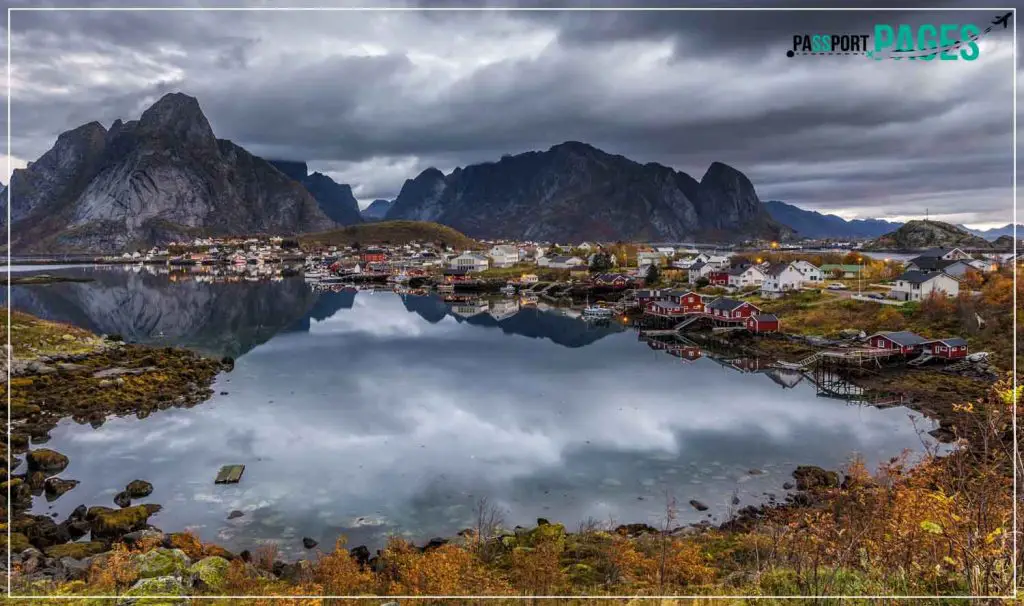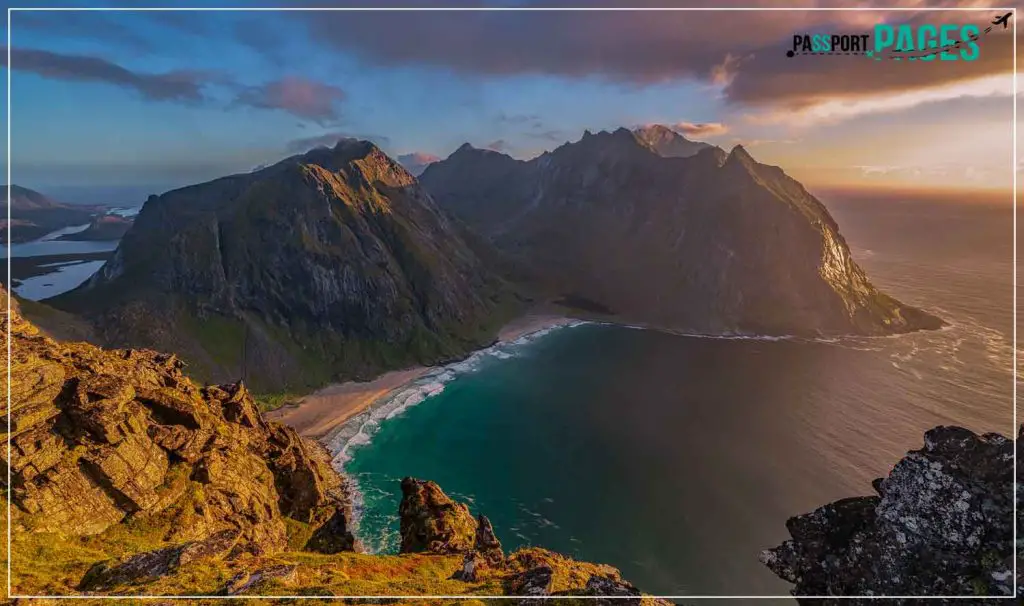Hikes in the Lofoten Islands are a captivating highlight of Norway‘s rich tourist destinations. The Lofoten Islands, which are located in Norway‘s stunning landscapes, are a symbol of both the country’s past and its current natural splendor. The Viking legacy, medieval history, and breathtaking fjords of Norway all contribute significantly to the country’s attraction as a tourist destination.
The striking mountain ranges of Lofoten, which are symbolic of Pulpit Rock and Trolltunga Norway and stand out and attract tourists from all over the world, provide thrilling hikes. Adventurers will find paradise on these islands, which also offer stunning scenery, fantastic fishing, and the chance to see the entrancing Northern Lights. The allure of Lofoten also includes quaint fishing towns, which are great for day visits and getting a taste of the Norwegian way of life.
Table of Contents
Lofoten Islands: Our Journal
When my partner and I decided to explore Northern Norway, the allure of embarking on hikes in the Lofoten Islands was irresistible. Our minds were filled with visions of majestic mountains rising from the sea, their rocky peaks inviting us to conquer the best trails Lofoten Islands had to offer. We dreamed of standing atop those peaks, gazing out at charming villages nestled amidst breathtaking landscapes.

Little did we anticipate the reality of boggy paths, relentless winds, stubborn low clouds, and frequent rain showers. If you’re reading this with a knowing smile, perhaps your vision aligns with ours, and you’ve already sensed the unpredictability of Lofoten’s weather.
It has been our pleasure to travel to the Lofoten Islands twice; our first trip was in the middle of August. Unfortunately, our first meeting was characterized by a lingering wetness, dampness, and a generally dreary environment.

We frequently realized that our boots were underwater, and we constantly searched for elusive patches of sunlight. It’s important to prepare for the possibility of rain, strong gusts, and even cold temperatures, especially during the summer, even as you daydream about those incredible views.
We all know that being cold and wet is not particularly enjoyable. We had this experience on our first visit, and it left us feeling a little disappointed. We came back the following year in mid-July, determined to explore the Lofoten Islands to its full potential (yeah, we count ourselves lucky!).
In dramatic contrast, our second visit featured a meeting with the midnight sun, warm, bright days, and little rain. Even while some paths remained muddy, it was nothing compared to last year. Our trusted raincoats were mostly unharmed.

It’s clear that I’m sharing our experiences to help you prepare for your own hiking adventures in the Lofoten Islands. As enchanting as this archipelago is, remember that Lofoten’s weather is capricious, capable of swift and dramatic changes. So, dream of those remarkable vistas, but packed with the understanding that versatility and preparedness will be your allies on these rugged trails of Lofoten Islands, where the unexpected is part of the adventure.
Facts About the Hikes in the Lofoten Islands
The trails are frequently exceedingly rocky and muddy.
Even between adjacent islands, the weather might differ.
Compared to the trailhead below, the mountaintop can feel significantly colder.
Even the easiest paths in Lofoten could be more challenging than usual.
Although most trails are unmarked, they typically have well-traveled paths.
It’s recommended to begin your journey early in the morning because parking spaces at trailheads are frequently extremely scarce.
Finding a trailhead can occasionally be challenging.
Navigation is usually not an issue, however in foggy or hazy situations, pay attention to drops or cliffs.
Best Time to Visit Lofoten Islands
Let’s address a key point before I go into the captivating locations found throughout the Lofoten Islands: the climate there is different in and of itself, with circumstances changing significantly throughout the year. Understanding when these islands are crowded with visitors and when you may enjoy their beauty alone is equally crucial.

Here’s my advice for making the most of your hikes in the Lofoten Islands:
Avoid the busy months of July and August if at all feasible. During these busy summer months, Lofoten Islands sees an increase in visitors, which frequently means navigating crowds and dealing with the occasional traffic jam while you’re there.
If you want to experience the romance of summer and see the ethereal midnight sun, think about scheduling your vacation around the first part of June. Choose September instead, if you want to enjoy warm, pleasant weather and the chance to see the beautiful northern lights.

If you want to see Lofoten covered in a perfect layer of snow, plan your trip around mid-February to mid-April. Wintertime offers more daylight hours, which makes it a great time for exploration. It’s important to remember that carrying the right gear is essential for hikes in the Lofoten Islands, especially those that cover the mountains listed below.
Reinebringen – The Most Iconic Viewpoint
Difficulty: Moderate
Parking: Free – Djupfjord or paid in Reine village
Camping: Camping is not allowed
Starting point: Djupfjord
Peak Elevation: 448m
Distance to the top: 2.2 km (one way)
Duration: Time to ascend from Djupfjord to Reinebringen viewpoint: 1 hour (one way)
Elevation climbed: 442m

Let’s get directly to the most well-liked hike in the entire Lofoten Islands archipelago. The view from Reinebringen is probably going to be the first thing you see when you look up pictures of Lofoten online, and let me assure you that’s for good reason—it’s simply stunning!
I will always treasure the memories of the magnificent sunrise, the mesmerizing sunset, and the breathtakingly brilliant northern lights that danced over the night sky. If you’re considering hikes in the Lofoten Islands, this one is a definite must. It is rated as one of the most interesting travel experiences I’ve ever had.
Munken – Couple’s Favorite Spot
Difficulty: Moderate
Parking: Sørvågen
Camping: Yes but not everywhere
Starting point: Sørvågen
Peak Elevation: 770m
Distance to the top: 6 km (one way)
Duration: Time to ascend from Sørvågen to Munken: 4 hours 30 minutes (one way)
Elevation climbed: 843m

My favorite mountain, Munken, comes to mind when I’m in the Lofoten Islands during peak season and want to get away from Reinebringen’s throng. Although the longer hike makes it less popular, I assure you that it is still worthwhile. The fact that Munken is taller than Reinebringen and so offers an even more beautiful vista is what makes it unique. The entire Reinefjorden, Forsfjorden, and Kjerkfjorden may be admired from Munken, providing breathtaking views.
We’ll pass the Munkebu hut on the route to Munken. We bought our tent, however, it would be a good idea to look over potential camping areas on their website. Munken is a fantastic pick therefore if you’re seeking less crowded hikes in Lofoten Islands that are just as magnificent.
Hermannsdalstinden – The Most Difficult Hikes in the Lofoten Islands
Difficulty: Very hard
Parking: Sørvågen
Camping: Yes but not everywhere
Starting point: Sørvågen
Peak Elevation: 1029m
Distance to the top: 10 km (one way)
Duration: Time to ascend from Sørvågen to Hermannsdalstinden: 8 hours (one way)
Elevation climbed: 1265m up and 420m down

Hermannsdalstinden is the mountain you should aim for to attempt to climb Moskenesoya, the highest peak on the southern island of Lofoten if you’re up for a true challenge. It’s quite different from the more well-known hikes in the area because it’s more difficult and remote.
The final stretch is extremely steep, so you should be ready for some major scrambling. But let me tell you, the view we’ll enjoy at the top will be well worth the effort. The 360-degree view is simply spectacular!
Hermannsdalstinden on Moskenesoya is one of the must-do hikes in the Lofoten Islands if we’re looking for an exhilarating adventure and are willing to take on a challenging climb.
Ryten – Lofoten’s Hidden Gem
Difficulty: Moderate
Camping: Yes
Peak Elevation: 543m
Distance to the top: 7.5 km
Duration: 5-6 hours
Elevation climbed: 560m

The distinctive topography of the Lofoten Islands offers practically limitless chances for treks with beach views, and it’s really simple to locate an amazing mountain hike that is concluded with a trip to a sandy beach! The discovery of Kvalvika, one of Lofoten’s most famous beaches, can be combined with a hike to Ryten for even more than just dramatic vistas. To start the day with a climb to Ryten and, if you’re feeling adventurous, a steep drop to the beach, we advise doing the challenging portion first.
Remember that the first part of the Ryten hikes could be muddy, therefore waterproof boots are advised! When you reach the summit of Ryten, you’ll be rewarded with panoramic views of the boundless ocean and a glimpse of Kvalvika. Descent from Ryten to the lake and follow the narrow trail that follows a stream that will bring you to the beach. Due to the steep terrain and uneven path, use caution.
Floya & Djevelporten Rock – The Best Viewpoint of Svolvaer
Difficulty: Moderate
Camping: Yes
Distance to the top: 5.5 km
Duration: 3-4 hours
Elevation climbed: 560m

Floya is undoubtedly the most well-known hike in Svolvaer and one that stands out when we visit. It promises a distinctive experience and provides amazing views of both the gorgeous coastline and the island-based town itself. If we’re searching for a replacement for the congested Reinebringen, this is a fantastic option.
Djevelporten, which is comparable to the well-known Kjeragbolten near Stavanger, is yet another intriguing location to explore. It has that daredevil element, challenging us to step upon a rock slab that hangs over a vast chasm. The Djevelporten slab is frequently visited by hikers as part of their ascent to Floya, and that is exactly what we did.
The hiking track to Floya and Djevelporten begins close to a nursery in Svolvaer. It demands strong balance and practical rock climbing skills because the first stretch of the trail is made up of enormous boulders that you must trek on. It is best to continue and climb over these substantial rocks since there is no way to avoid them.
Ignore all routes that differentiate to the right and continue walking straight ahead to the little opening in the rock up ahead. We advise traveling to Djevelporten first. The trail, which winds through loose rock, steepens as you come nearer the rocky hills that house Djevelporten.
Final Thoughts!
Now you are aware of our top hikes in the Lofoten Islands. Of course, there are alternative options, and picking a different walk is probably not a mistake. The islands of Lofoten are stunning everywhere. In Lofoten, the weather is unfortunately unpredictable, so it’s wise to have a backup plan besides hiking.
FAQs
What risks should hikers in the Lofoten Islands be aware of?
Rapidly shifting weather, rocky and steep terrain, and slick conditions are common hazards. Always keep an eye on the weather, let someone know what you’re doing, and be ready to be safe.
Can I camp during multi-day hikes in the Lofoten Islands?
Yes, camping is allowed in many locations throughout the Lofoten Islands, but you should be aware of the particular guidelines, particularly in protected areas. Respect for the environment and responsible camping are crucial.
What must you bring with you if you want to hike in the Lofoten Islands?
Sturdy hiking boots, weather-appropriate clothing, a map or GPS device, ample water and food, a first-aid kit, and a fully charged phone are important items to bring. Be ready for the weather to change at any time.
Are there any Lofoten Islands guided hiking tours available?
Yes, you may find different ability-level-appropriate guided hiking tours in the Lofoten Islands. The expert tour guides on these excursions might make your hiking experience better.





